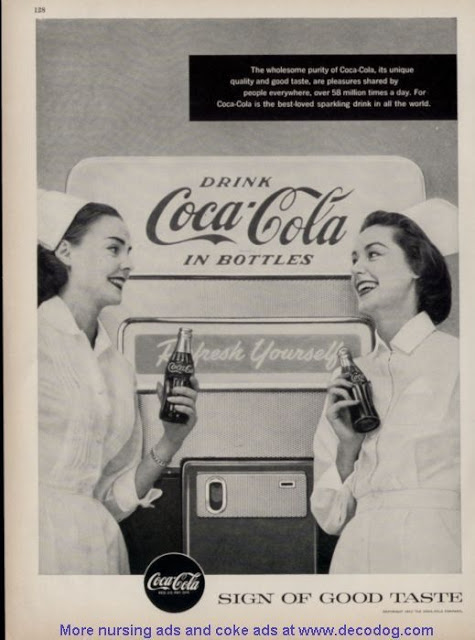Fortunately, they did not live to see the sad fate of the hospital. By 2001 the physicians' group owner began to seek a buyer, but not finding one had to file for bankruptcy in September 2006. Another group of physicians purchased the facility; it was unable to keep it afloat. The huge 617-bed hospital closed for good on Halloween 2008. Efforts to re-purpose the site have so far been unsuccessful.
You can visit photos of the ruin via Abandoned Southeast. A video visit is available on YouTube.
The photo below shows two nurses at what was probably Norwood Clinic in the 1940's. The park bench on the left and the visiting hours sign perhaps indicates an outdoor area at the hospital available for both patients and staff.
Just for fun I've also included below a number of advertisements for Coca Cola that feature nurses. Most are probably from the 1950's and rely on growing popular attitudes about the competency of the nursing profession.
A good history is Anita Smith's 1996 book A Culture of Excellence: A History of Carraway Methodist Medical Center. 2 vols.
Photo by Charles Preston
Source: Birmingham Public Library Digital Collections
Physicians Medical Center Carraway at the time it closed in October 2008
Source: BhamWiki
Charles Carraway, M.D., about 1920
Source: Wikipedia
This article examines the use of nurses as authority figures in advertising after
World War II:
Johnson E. "Who would know better than the girls in white?" Nurses as experts in
postwar magazine advertising, 1945-1950. Nursing History Review. 2012;20:46-71
American advertising in the period immediately following the Second World War
portrayed nurses as trusted advisers and capable professionals and frequently
pictured them performing skilled work, including dispensing medicine and
assisting in surgery. Advertisements published in a range of magazines whose
target audiences varied by gender, race, age, and class show that nurses in
postwar advertisements embodied two broad categories of representation: (a)
medical authority, scientific progress, and hospital cleanliness; and (b)
feminine expertise, especially in female and family health. Typically portrayed
as young white women--although older nurses were occasionally depicted and black
nurses appeared in advertisements intended for black audiences-nurses were
especially prominent in advertisements for menstrual and beauty products, as well
as products related to children's health. Although previous scholarly
examinations of nurses in postwar mass media have emphasized their portrayal as
hypersexual and incompetent, this investigation posits postwar advertising as a
forum that emphasized nurses' professionalism, as well as complex expectations
surrounding women's professional and domestic roles.

















